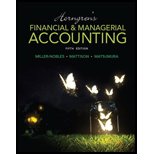
Concept explainers
Dividing cash dividends between preferred and common stock
Platinum Trust has the following classes of stock:
Common Stock-$0.20 Par Value; 2,250,000 shares authorized, 1,650,000 shares issued and outstanding
Requirements
1. Platinum declares cash dividends of $20,000 for 2016. How much of the dividends goes to preferred stockholders? How much goes to common stockholders?
2. Assume the preferred stock is cumulative and Platinum passed the preferred dividend in 2014 and 2015. In 2016, the company declares cash dividends of $50,000. How much of the dividend goes to preferred stockholders? How much goes to common stockholders?
3. Assume the preferred stock is noncumulative and Platinum passed the preferred dividend in 2014 and 2015. In 2016, the company declares cash dividends of $50,000. How much of the dividend goes to preferred stockholders? How much goes to common stockholders?
Want to see the full answer?
Check out a sample textbook solution
Chapter 13 Solutions
Horngren's Financial & Managerial Accounting (5th Edition)
- Hendrix Corporation had annual sales of $75 million, which occurred evenly throughout the 365 days of the year. Its accounts receivable balance averaged $3 million. How long, on average, does it take the firm to collect on its sales? Answerarrow_forwardKichi company had the following informationarrow_forwardWhat is the flexible budget net income?arrow_forward
- Hendrix Corporation had annual sales of $75 million, which occurred evenly throughout the 365 days of the year. Its accounts receivable balance averaged $3 million. How long, on average, does it take the firm to collect on its sales?arrow_forwardWhat was the dollar amount of under allocated or overallocated manufacturing overhead ?arrow_forward5 POINTSarrow_forward
- False Value Hardware began 2013 with a credit balance of $31,900 in the allowance for sales returns account. Sales and cash collections from customers during the year were $680,000 and $640,000, respectively. False Value estimates that 5% of all sales will be returned. During 2013, customers returned merchandise for credit of $23,000 to their accounts. False Value's 2013 income statement would report net sales of: a. $657,000. b. $646,000. c. $648,100. d. $671,100.arrow_forwardCapitalisation methodarrow_forwardSubject: financial accountingarrow_forward
 Financial Accounting: The Impact on Decision Make...AccountingISBN:9781305654174Author:Gary A. Porter, Curtis L. NortonPublisher:Cengage Learning
Financial Accounting: The Impact on Decision Make...AccountingISBN:9781305654174Author:Gary A. Porter, Curtis L. NortonPublisher:Cengage Learning Excel Applications for Accounting PrinciplesAccountingISBN:9781111581565Author:Gaylord N. SmithPublisher:Cengage Learning
Excel Applications for Accounting PrinciplesAccountingISBN:9781111581565Author:Gaylord N. SmithPublisher:Cengage Learning Cornerstones of Financial AccountingAccountingISBN:9781337690881Author:Jay Rich, Jeff JonesPublisher:Cengage Learning
Cornerstones of Financial AccountingAccountingISBN:9781337690881Author:Jay Rich, Jeff JonesPublisher:Cengage Learning Intermediate Accounting: Reporting And AnalysisAccountingISBN:9781337788281Author:James M. Wahlen, Jefferson P. Jones, Donald PagachPublisher:Cengage Learning
Intermediate Accounting: Reporting And AnalysisAccountingISBN:9781337788281Author:James M. Wahlen, Jefferson P. Jones, Donald PagachPublisher:Cengage Learning Financial & Managerial AccountingAccountingISBN:9781285866307Author:Carl Warren, James M. Reeve, Jonathan DuchacPublisher:Cengage Learning
Financial & Managerial AccountingAccountingISBN:9781285866307Author:Carl Warren, James M. Reeve, Jonathan DuchacPublisher:Cengage Learning





